Japanese Red Army: Partisan War in the Land of the Rising Sun
Radically minded student and marginal youth in Western Europe and the USA was inspired by the example of the heroes of Latin American rebel movements - Che Guevara became a real symbol for radical youth in all countries, and one of the West German anarcho-terrorist groups was even called "Tupamaros of West Berlin" (imitating the Uruguayan partisans ).
Stormy Sixties in Japan
The surge of youth radicalism did not bypass Japan, which by the end of the 60-s had taken a firm place in the system of industrialized capitalist countries. As in European countries, a mass movement of new leftists already existed in Japan for 1968, in which student youth from Tokyo's universities played a leading role. The new leftists criticized the moderate policies of the pro-Soviet Communist Party and advocated the radicalization of the political course. In the spring of 1968, thousands of young people took to the streets of Tokyo, Yokohama, Osaka, and many other cities in the country to protest against the US war in Vietnam, against US military bases in Japan, and against the capitalist system as such.
The left-wing groups played a leading role in these events, while the Communist Party consistently denied excessively radical youth. The final result of this position was the final gap between the pro-Soviet communists and the radical-minded students. Among the latter, the works of Trotsky and Marcuse were already extremely popular at that time, and the Soviet doctrine of “peaceful coexistence” was sharply criticized.
Maoism has come to the fore in the Japanese youth movement. This was due to several reasons. Firstly, the Maoists occupied much more radical positions than the pro-Soviet communists. Secondly, there was China, led by Mao Zedong, who could provide real assistance to the beginning Japanese revolutionaries. Completely breaking with the Soviet line, radical students put forward their leaders, their ideologues and their idols.
After the suppression of student unrest of 1968, the most radical left-wing organization, Sengakuren, emerged the most radical wing - a group of students from Tokyo headed by 26-year-old Tsuneo Mori. In the middle of 1969, the Mori group formed into the organization of the Japanese Communist League - the Red Army Faction (Sekigun-ha) and proclaimed its goal the world communist revolution. The sekigunov team held their first combat action in the spring of 1970, when a special group “Yodo-go”, consisting of nine students and led by Yoshimi Tanaka, captured an aircraft of the company “GiAl”.
Most of the radical youth of Japan reacted very positively to the first terrorist acts of their like-minded people. New organizations of young revolutionaries began to appear. In the same 1969 in Yokohama, the Council for the Joint Struggle against the "Security Treaty" (Keihin Ampo Keto) was created, headed by 27-year-old Hiroko Nagata. The organization included 13 people, mostly students, oriented towards Maoism. The Nagata group also proclaimed a course towards armed guerrilla warfare and made its debut in the same 1969, when its activists pelted the territory of the US and USSR embassies with Molotov cocktails. Later, the Yokohama leftists carried out several expropriations of large banks and armory shops.
United Red Army
In an interview with one of the central newspapers, Hiroko Nagata formulated her position in this way: “A couple of years ago I had a great interest in Mao’s ideas and I began to read out his works. It was they who inspired me to the revolutionary struggle. "
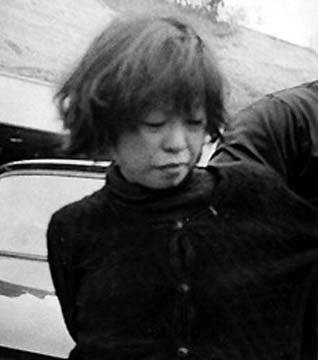 Soon the activities of the Yokohama Maoists were closely intertwined with the activities of their Tokyo-minded people from Sekigun-ha. This happened in the late autumn of 1971, when fleeing from police persecution, activists from both leftist organizations took refuge in the remote mountainous region of Nagano and Gunma prefectures. Here, in mountain caves, equipped as shelters for the partisans, the two organizations merged into one, called the United Red Army (Rengo Sekigun).
Soon the activities of the Yokohama Maoists were closely intertwined with the activities of their Tokyo-minded people from Sekigun-ha. This happened in the late autumn of 1971, when fleeing from police persecution, activists from both leftist organizations took refuge in the remote mountainous region of Nagano and Gunma prefectures. Here, in mountain caves, equipped as shelters for the partisans, the two organizations merged into one, called the United Red Army (Rengo Sekigun).The 31 member entered the OKA, the average age of the revolutionary partisans ranged from 16 to 28 years. The Central Committee of the OKA was formed, Tsuneo Mori was elected as its chairman, Hiroko Nagata and another Yokohama man Hiroshi Sakatuti were elected as his deputies. Under strict secrecy, when every careless step of one of the activists could turn into failure and arrest of all partisans, the life of the cave commune was subordinated to a clear routine - it was forbidden to go beyond the shelter without a sanction of leadership, combat training and hand-to-hand fighting were conducted daily, the works were studied Marx, Mao Zedong and Trotsky. From time to time, the Japanese "Red Army" made military attacks in the surrounding villages, where they seized food and necessary medicines.
Naturally, not all of them, even from fanatically minded activists of the organization, were capable of prolonged trials - when romance disappeared, it came to the realization of the very sad days of partisans hiding in the caves. Some of the “Red Army men” began to grumble and incline to the fact that they should voluntarily surrender to the police or at least return to the city. To protect yourself from possible betrayal has become one of the most important tasks of the organization. The Central Committee, according to a proven tradition, decided to resort to purging the ranks. Several people were accused of bourgeois rebirth and executed by an organization’s decision. Among the dead was pregnant Kaneko. In total, 14 activists accused of panic and “bourgeois rebirth” were killed.
However, in February 1972 guerrilla bases were still discovered by the police. This was the case. A squad of eleven people (all that remained of the organization after the internal "cleansing") moved through the mountainous territory, but was noticed by local residents who reported what was happening to the police. “Red Army men” were divided into two groups of six and five people. The first group in which OKA leaders, Hiroko Nagata and Tsuneo Mori, were walking, was briefly detained by the police after a short time. The second group of five people was able to get away from the chase and after the transition, which lasted 72 hours, 19 February 1972 of the year to go to the boarding houses on the Osama-Sanso mountain. The Red Army soldiers entered one of the divisions, taking the ruler's wife hostage. The latter, who had quit the dog for a walk, called the police. The siege of the hotel began, which turned into a real fortress for the Japanese radicals. The hotel turned off the electricity, brought the parents of several “Red Army men” to the boarding house, but the latter did not talk to their older relatives, but opened fire on them from the windows of the hotel and the police were forced to abandon their idea.
After 9 days, 28 February, 1972, the assault on the hotel began. Police punched holes in the walls of the guesthouse through which the fighters of special groups penetrated. "Red Army" shot back and stubbornly kept the defense. During the first two hours of the operation, the police lost two people killed and several wounded, but were able to capture only the lower floors of the boarding house. OKA militants have strengthened on the top floor. The police were forced to use fire equipment that poured cold water on the Red Army men. In 18.10 28 February, the police still managed to arrest all five OKA militants and free the hostage.
In parallel with the United Red Army, in the first half of the 1970-ies, an organization called the Armed Anti-Japanese Front of East Asia also showed marked activity. It is noteworthy that under the name "anti-Japanese" the Japanese themselves performed. The purpose of the organization was proclaimed a comprehensive struggle against external and internal Japanese imperialism. The organization’s activists attributed to external imperialism Japan’s support of the aggressive US foreign policy in East and Southeast Asia, and cooperation with Taiwan. The manifestations of internal imperialism included the Japanese colonization of the Ryukyu archipelago and the territories of the traditional residence of the Ainu, who were regarded as a oppressed national minority.
The anti-Japanese front carried out several armed attacks on the offices of multinational companies. During an explosion at the Mitsubishi 30 office in August 1974, a man died, which was a shock for front-line activists who did not want to kill random people. Soon enough, the police managed to get on the trail of the front-line soldiers and detain its five activists. Two were sentenced to death, one to life imprisonment.
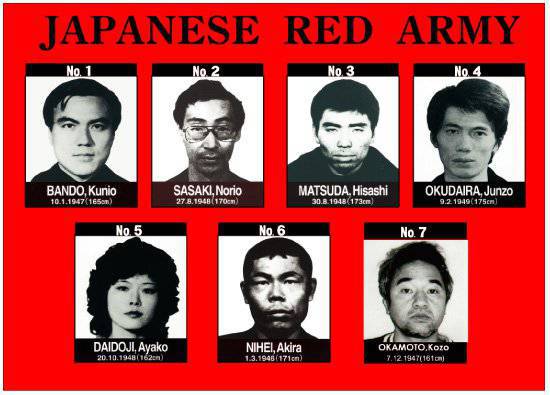
Red Army of Japan
In 1972, the Red Army of Japan (Nihon Sekigun) was revived from the remnants of the United Red Army. Very soon, KAYA recovered from the losses and increased the number of its fighters to 300-400 people, and sympathizers and reservists to 1500.
At the head of Kaya were the leader of the new left, Such Siomi, and former dancer Fisako Shigenobu. Fisako Shigenobu (born 1945) is one of the most famous women of the left-radical terrorist organizations of the second half of the twentieth century.
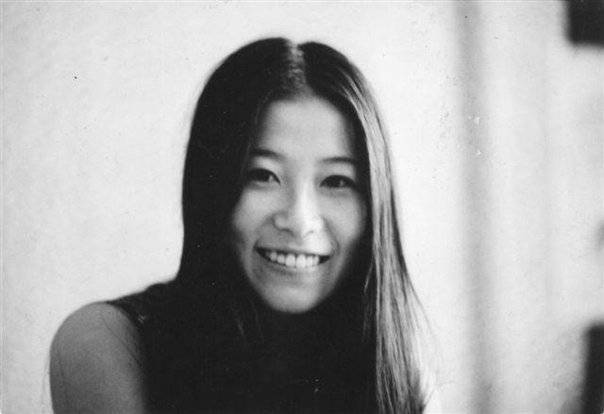
In ideological terms, KAYA experienced a particularly strong influence from the ultra-left theorist Ota Ryu, who criticized Maoism from the left. The forty-year-old Ota Ryu (1930-2009) participated in the activities of the Communist Party of Japan since 1947, but already left its ranks in 1953 and in 1955, together with Kuroda Kaniti, created the Japanese Revolutionary Communist League, which began to represent the Trotsky Four in the Land of the Rising Sun. International. In 1970, his own teammates were sentenced to death for withdrawing from the Ots Ryu Trotsky League. In 1971, Ryu tried to raise a rebellion of the Japanese Ainu, but was arrested along with the leader of the Ain Liberation League.
Following Ota Ryu, its program goal declared that the world communist revolution, which can be accomplished only as a result of the world revolutionary war (Ota Ryu did not rule out the positive significance of nuclear conflict for the revolution). To accomplish the world revolution, Kaya envisioned the creation of the Red Armies of Japan, Korea, Africa and Latin America, and their subsequent unification into the World Red Army, the World Revolutionary Party and the World Revolutionary Front. As a result of the communist revolution on the territory of the whole world, the creation of a communist republic without a state, family and private property was proposed. The leading theorist of the Red Army of Japan, Such Siomi, emphasized that "revolutions are not the result of mass struggle, but are the result of armed violence."
A characteristic feature of the Red Army of Japan was the extraordinary fanaticism of its activists (the national color affected - Maoists from KAYA also had a “samurai spirit”). Committed terrorist acts, the "Red Army" preferred to die with weapons in their hands or to commit suicide than to fall into the hands of the enemy. The Red Army of Japan was distinguished in a favorable direction from other left organizations by the highest discipline based on the inevitability of internal violence against doubting and unreliable activists. Very soon, KAYA, built on the strictest discipline and ideological devotion of all activists, became one of the most serious left-wing armed organizations in the world.
KAIA has established close relations with the Palestinian national liberation movement, primarily with the Georges Habash grouping, the Popular Front for the Liberation of Palestine, as well as with the Syrian government and with the international revolutionary Ilich Ramirez Sanchez, nicknamed “Carlos Jackal”. In solidarity with the Palestinian liberation movement, the Red Army of Japan proclaimed the Israeli aggressors to be one of their main enemies. KAIA provided very effective assistance to Palestinian freedom fighters - usually the Red Army militants committed sabotage acts on behalf of the Palestinians.
Thus, in the spring of 1972, the Red Army of Japan conducted its most famous operation, “Big Target,” better known as “shooting at Lod Airport”. At the request of the command of the Popular Front for the Liberation of Palestine, three militants of the Red Army of Japan, Kodzo Okamoto, Rakeshi Okudeira and Yoshuiki Yasuda, arrived at the partisan bases in Lebanon. At Lebanese bases, they underwent a three-month special training course, after which they were flown to Rome, where they received weapons (Czechoslovak-made machines and Soviet grenades) and 30 on May 1972 flew Rome-Tokyo flight with an intermediate landing at Lod airport in Israel. Right at the airport, the Japanese opened fire with machine guns on the townsfolk there - Israelis and tourists from Puerto Rico. 26 was killed and 70 people were injured. Rakeshi Okudeira and Yoshuiki Yasuda died in a battle with the police. Kozo Okamoto was arrested and imprisoned, and later exchanged for prisoners captured by Palestinians.
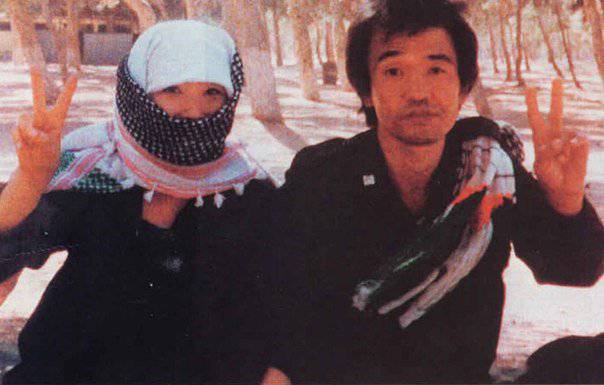
It is necessary to briefly talk about this man, because he is one of the few living militants of Kaya. Kozo Okamoto was born in 1947 in Japan, in a fairly prosperous family, and after graduating from school he went to study at the Botanical Academy. The fluency in Arabic, Hebrew, and English languages played a role in the fact that it was this young Maoist who was selected by Kaya leaders to participate in hostilities in the Middle East. Since the beginning of the 1970's. Okamoto was in Lebanon, where he received training at the training camp of the Palestine Liberation Organization. Okamoto became one of the three Japanese "Red Army" who participated in the famous shooting at the airport "Lod".
In the same 1972, a group of revolutionaries from KAYA numbering 50 people, guided by the principle of creating "support bases" in other countries, left Japan. Its headquarters was deployed in Lebanon by Kaya, then the organization’s focal point was moved to Paris. In France and a number of other Western countries, the Japanese began operations to kidnap businessmen for ransom. In 1975, KAYA transfers its activities to the countries of Southeast Asia, primarily to Malaysia, Singapore and Indonesia. In August, 1975 ten revolutionaries seized the US Embassy in Kuala Lumpur (Malaysia) and released the hostages only after the five Red Army soldiers arrested were released from prison. One of the biggest acts of KAIA was the seizure of hostages by the 1977 in September in Bombay on board the 159 passenger aircraft.
After lengthy negotiations, revolutionaries exchanged captured hostages for six million dollars and six of their comrades held in prisons in Japan. Political asylum participants in the operation received on the territory of Algeria. Due to the persecution of the special services of most capitalist countries, KAJ was forced to "lay low" and stop operations on its own behalf. The part of the activists of the army, which left Japan, settled again in Lebanon and Syria, where bases and training camps were equipped. Five militants who still captured a Japanese plane in 1970 were granted political asylum in North Korea. However, the cessation of speeches by Kaya did not mean the cessation of military operations by all Japanese leftists.
Eighties radical groups
In the 80s, Japanese revolutionaries came out under the name of Anti-imperialist international brigades. AIB conducted the bulk of the military operations of the Japanese left outside of Japan proper in the second half of the 80s. So, in June 1987, AIB detonated bombs at the US and British embassies in Rome, and in the summer of 1988, the Club of American military personnel in Italy was blown up, resulting in the death of five invaders. AIB explained its actions as a protest against the bombing of the American aviation Libya in 1986. The structure of the brigades has not been well studied, therefore, according to one point of view, AIB is an independent left-wing radical Japanese group, according to another, under the name AIB, KAJ activists who have gone underground are hiding.
Since the beginning of 90's, almost nothing was heard about the Red Army of Japan: the militants who remained at large were hiding from the Japanese and American intelligence services in North Korea and Lebanon, and there were no new military operations. However, the actual cessation of KAI activity does not mean that the revolutionary armed movement in Japan has died down. Other leftist organizations took the baton from KAYA. The largest of these was the Central Core Grouping (Chukaku-ha), which broke away in 1967 from the Communist Party of Japan.
Tyukaku-ha acted both as a legal ultra-leftist party and as an illegal armed organization (the military wing of Tyukaku-ha - the Kansai revolutionary army). The number of Chukaku-ha during the peak activity reached 3500 armed partisans - this is the largest armed radical left organization in Japan. Since the middle of the 80s, Chukaku-ha has come out on top in terms of the number of terrorist operations in the country. A characteristic feature of the military operations of Tyukaku-ha was the widespread use of missiles to fire on certain objects.
In January, outside Japan, 1986 activists of the Red Army of Japan called on Tyukaku-ha and other Japanese leftists for armed action against the imperial family and the country's leadership. At the end of March, 1986 militants Tyukaku-ha, along with people from the Hadzam faction of the Revolutionary Workers' Council, fired missiles at the Imperial Palace, the Crown Prince's Palace, the US Embassy, and the Osaka Police Department. At the beginning of July, 1993 of the year, before the G7 meeting in Japan, Tyukaku-ha conducted a series of sabotage operations: on July 1 the US Air Force base was fired at rocket launchers, and on July 7 revolutionaries fired missiles at the US Air Force headquarters in Japan and detonated a bomb in Technological UN Center in Osaka. Along with the overthrow of the monarchy and the establishment of a socialist system, Tyukaku-ha proclaimed the expulsion of American troops from the country's territory as one of its main goals.
The Revolutionary Workers Council (Hadzam) is the second largest and most significant Japanese leftist armed organization of the 1980s, operating in close conjunction with Tyukaku-kha. November 29 1985 of the Year The Revolutionary Workers' Council conducted its most large-scale operation, timed to strike railway workers. The radicals from Hadzam supported the demands of the striking workers, and on the appointed day they actually brought down the Japanese railways: electrical cables were cut, computers were put out of action, and in some sections the rail was blown up. The operation involved up to 700 militants Hadzam. As a result of the coordinated actions of the leftists, traffic was stopped on the highways, several large train derailments occurred, and the government was damaged in millions of dollars. On the example of Tyukaku-ha and Khadzam, it is revealed that the leftists of 80-xNNXX-s also brought a lot of new things into the tactics of sabotage, in particular they turned to disabling the communication system (Kaya did not deal with such actions).
At present, the left-wing radical organizations of Japan do not conduct any military operations on the territory of the country and practically do not undertake armed attacks. Nevertheless, some former militants of the Red Army of Japan are in some Asian and African countries, not intending to return to their homeland. Officially, the dissolution of the Red Army of Japan was announced by its head Fisaco Shigenobu in April 2001, and in October 2001, the American special services excluded KAIA from the number of existing terrorist organizations. Thus, the path of one of the most aggressive and dangerous terrorist organizations in the world has ended.
The fate of the key activists of the Red Army of Japan was formed, in the end, for the most part in the same way - those who did not die were sooner or later arrested and put in Japanese prisons.
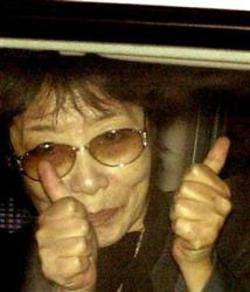 Organization leader Fisako Sigenobu was arrested in Osaka in November 2000, and in February 2006 was sentenced to 20 years in prison for a series of assaults, kidnappings and car thefts. Haruo Wako was arrested in February 1997 of the year. Osamu Maruoka, arrested in 1987 and sentenced to life imprisonment, died in prison. Yu Kikumumra was arrested in the USA and from 1988 to 2007. was imprisoned. Twelve years in prison received Yoshimi Tanaka, twenty years - Yukiko Yekida. Kunia Akagi, who collaborated with the Irish Republican Army, was arrested after returning to Japan on charges of involvement of Japanese citizens in the abduction of North Korean intelligence.
Organization leader Fisako Sigenobu was arrested in Osaka in November 2000, and in February 2006 was sentenced to 20 years in prison for a series of assaults, kidnappings and car thefts. Haruo Wako was arrested in February 1997 of the year. Osamu Maruoka, arrested in 1987 and sentenced to life imprisonment, died in prison. Yu Kikumumra was arrested in the USA and from 1988 to 2007. was imprisoned. Twelve years in prison received Yoshimi Tanaka, twenty years - Yukiko Yekida. Kunia Akagi, who collaborated with the Irish Republican Army, was arrested after returning to Japan on charges of involvement of Japanese citizens in the abduction of North Korean intelligence. The only survivor of the Kaya militants who shot civilians at the Lod airport in Israel, Kozo Okamoto converted to Islam and joined the Palestinian national liberation movement. For some time he lived in Libya and Syria. In 2000, he was granted political asylum in Lebanon (albeit, before that, he served a small prison sentence for forging passports). Despite numerous inquiries from Japan regarding the extradition of Okamoto to Japanese justice, there is no response from Lebanese law enforcement agencies. Okamoto continues to reside in Lebanon, enjoying political refugee status.
By the way, Lebanon and Syria for a long time gave political asylum to the soldiers of the Red Army of Japan, minding their merits in the national liberation movement of Palestine, but in the 1990-s. Lebanese authorities gradually began to squeeze the Japanese "Red Army" out of the country, not wanting to aggravate relations with the world community. It is known that some former members of the Red Army of Japan fled to the Philippines. It is possible that one of them could, up to the end of the 1990's. to participate in the training of militants of the Filipino rebel groups of Maoist orientation, above all - the New People’s Army of the Philippines
As for the left-wing theorist Ota Ryu, whose views had a significant influence on the worldview of the “Red Army men,” from the second half of the 1980-s he moved away from active work in the framework of the communist movement and moved to the position of radical ecologism. However, in this field, Ryu was distinguished by a significant extravagance of statements. Thus, he called for the overthrow of the dictatorship of people and the release of all living beings, including worms and cockroaches. In 1990, it was Ota Ryu who became one of the popularizers of the anti-Semitic conspiracy theory in Japan, he also wrote books about the detrimental consequences of westernization for Japanese society and the moral superiority of the Japanese over European civilization.
Information